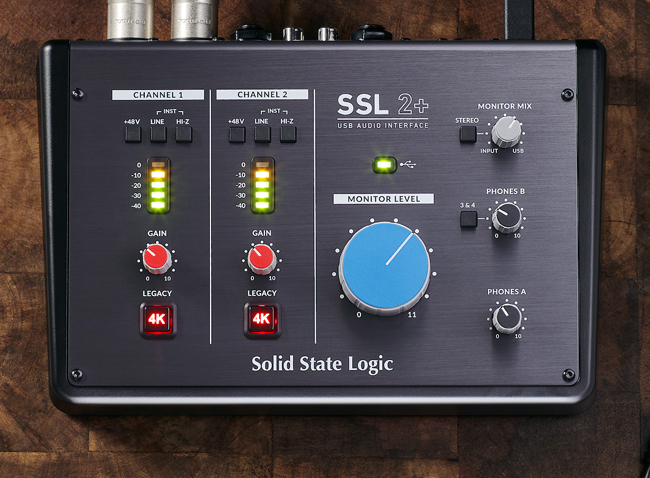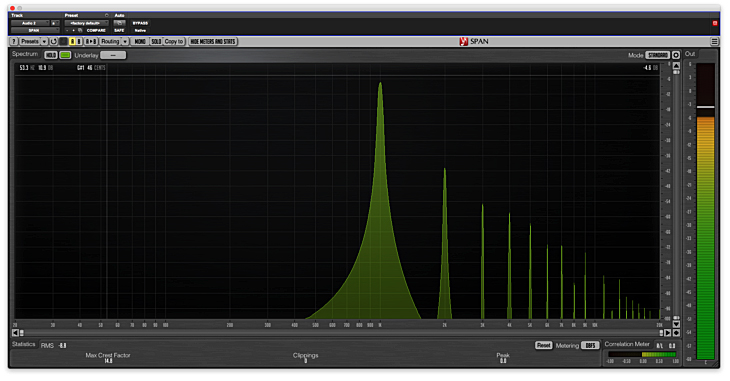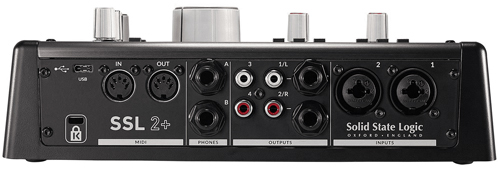
Barry's Mix Magazine Equipment And Software Reviews
Barry's Massive Discography And Engineering Career
Barry's Music Connection Magazine Reviews
Barry's Resolution Magazine Reviews
Solid State Logic SSL 2 and SSL 2+ Interfaces
By Barry Rudolph
 | Solid State Logic SSL 2+ Interface |
Solid State Logic's experience in design and manufacture of professional analog and digital audio gear is clearly evident in the thoughtful design of the company's first desktop USB-powered audio interfaces. SSL offers two versions: the 2-input/2-output SSL 2 and the 2-in/4 out SSL 2+. Both models operate at up to 24-bit/192 kHz using AKM AD/DA converter chips, and they are class-compliant on Mac computers with no driver required. PC users will need to download SSL's USB Audio ASIO/WDM driver (included).
Both the SSL 2 and 2+ are well-made desktop units that are identical in size at 9.2 (W) x 6.2 (D) x 2.75 (H) inches, including the control knob's height. They have pleasantly sloped top panels, and each weigh less than 2.2 pounds. Manufacturing cost is kept low by using the same circuit board inside for both models; a different metal top plate and rear panel are used to accommodate the extra jacks and pots for the SSL 2+. A check of the technical specifications for both models reveals that they are identical--the sound, performance and operation are the same for either model.
Both start with SSL's microphone, line and instrument pre-amplifiers. Channels 1 and 2 are each capable of up to 62 dB of gain with a microphone input impedance of 1.2 k-Ohm. For 99 percent of recording tasks, this is more than enough mic gain to accommodate low-output ribbon or vintage dynamic mics without the necessity of an external, in-line booster amplifier.
There are two Neutrik XLR Combo 1/4-inch connectors on the back panel that accept either low-impedance microphones (XLRs) or high-impedance direct instruments, and/or line level via their integrated 1/4-inch TRS/TS jacks. All three input paths are specified with an A-weighted dynamic range of 110.5 dB.
Also identical on both models are three separate push-button switches for Channels 1 and 2 to select: +48-volt phantom, line level, or a 1-megaohm high-impedance input for direct connection of a guitar or bass. I liked the straight-ahead input level metering provided by five LEDs that show the input level from -40 to 0 dB (clip)--the manual offers good suggestions about setting record levels with the red Gain control knob. All switches are made by ALPS.
Finally, there is a lighted "4K" button that adds a combination of high-frequency boost and subtle harmonic distortion. This is the sonic profile endemic to the SSL 4000 Series consoles when driving their inputs hard to near clip.
Both the SSL 2 and SSL 2+ use a large level/volume control knob to set the level out of a pair of 1/4-inch TRS rear panel jacks for outputs 1 and 2. These stereo balanced line-level outputs are capable of a maximum of +12.5 dBu. The maximum output level of the stereo headphone jack is +10 dBu driving down to 10-ohm impedances.
Modern Monitoring Input/USB
Monitoring input audio does not necessarily rely on the DAW. This is handled well for an inexpensive USB interface. There is a Monitor Mix blend control that sets the balance between Input, or the live audio coming into the SSL 2's input channels 1 & 2, and USB, or the audio returning from the DAW over the USB C to USB A cable (supplied).
Once you have a proper recording level, you can then mix in the DAW's backing track(s) in any proportion. Because this is all hardware mixing, there are no delays in adjusting this or what you're hearing, and no worries about your DAW's inherent latency. If you like to hear reverb on your microphone while singing, you can add it (using a pre-fader send) to your vocal track back in the DAW.
I liked the Stereo switch option for monitoring input sources that, when pushed, automatically causes Channel 1 to be panned to the left side and Channel 2 on the right. When the Stereo switch is not pushed, the source audio from either channel is forced to the center for monitoring. The DAW audio stays stereo, but what you're recording is center-panned.
 | Frequency Graph of The SSL 4000 Legacy Harmonics |
More With the SSL 2+
From here on, the two models diverge, with additional feature sets on the SSL 2+. While the SSL 2 is perfect for single-operator usage, the SSL 2+ is designed for multiple people in collaborative situations.
The SSL 2+ adds: MIDI input and output on 5-pin DIN jacks; an unbalanced stereo output that "mirrors" the main balanced 1/2 outputs; and another unbalanced stereo output, called 3/4, whose level is controlled back in the DAW. Both these additional sets of outputs are on RCA jacks and designed for interfacing DJ rigs. The manual offers a few configurations and uses for this additional I/O.
The SSL 2+ has a second stereo headphone output jack on the rear panel called Phones B, with its own front-panel level control. You can switch this headphone source between output 3/4 or the main mix on output 1/2. In your DAW mixer, you may configure a separate mix for output 3/4 and switch between it and your main mix. In main mix mode with the 3/4 switched up, you still have two cue systems with separate volume controls, but both controlled by the single Monitor Mix blend control.
The only feature I wish for the SSL 2 and 2+ would be a hardware insert jack(s) to add a compressor or EQ into the record path.
In the Studio
My first use of the SSL 2 was for a Zoom Meeting interface. I now maintain the SSL 2 as my main Mac Core audio device for all audio sources I encounter on the Web--YouTube, Skype, FaceBook, etc.
After changing the Input and Output settings in the Mac's Sound window and connecting a pair of IK Multimedia iLoud MTM Reference Monitors to the 1/2 output jacks of the SSL 2. I connected an AKG C-314 Condenser Mic, turned on the unit's phantom power supply and set the gain on Channel 1 to straight up at about the noon position. Just inches away from (in this case) a studio-quality mic, this is a great way to get rid of that "boxy room tone" I hear on most podcasts and on attendees' audio at Zoom meetings. This is the ultimate Zoom audio possible!
Next I booted up Pro Tools HD Ultimate 2020.3 HDX and switched the Playback engine to "SSL 2+." I recorded vocals, a bass guitar using a Jensen Iso-Kit Direct Box, an electric guitar amp using a lower-output Royer R-10 Ribbon Mic, and typical dynamics and condenser mics for small percussion. I always had plenty of gain to work, with the Channel Gain controls "hitting all yellow" LEDs as recommended by the manual.
I thought the Monitor Mix control worked very well. I made sure that the interface input and output levels inside the Mac were at unity. With the DAW track faders all at 0 dB, I could monitor either 100 percent "Input" (source) or "USB" as returned from Pro Tools or anywhere in between as needed for overdubbing.
 | Solid State Logic The SSL2+ Rear Panel |
I liked using the 4K buttons almost all the time. I found that it helped out a (purposely) dark-sounding Microphone-Parts S-87 Condenser Mic Kit I had built, but 4K was too bright for use with the C-314. 4K sounded good for acoustic guitars. It helps in the studio to have this "push-button" option, but when talking on Zoom meetings, as I expected, nobody could tell the difference. It is a subtle change except when tracking loud instruments with high RMS levels, such as electric guitars or sustaining synthesizer pads.
All Things Great and Small
Both of these interfaces are bundled with a big collection of music software and samples. There are perpetual licenses for SSL Native Vocalstrip 2 & Drumstrip plug-ins, plus a six-month trial period to evaluate the rest of the SSL plug-ins. It comes with Avid Pro Tools | First, including an exclusive SSL collection of AAX plug-ins.
You get Native Instruments Hybrid Keys & Komplete Start with 2,000 customizable sounds of drums/percussion, bass, acoustic instruments, synths, pads, atmospheres and effects. Also included are Ableton Live Lite with 1.5 GB of curated samples from Loopcloud and SSL.
I think SSL has a big winner with these two new USB interfaces! Hard to argue with their effective and simple operation, clean sound and rugged construction.
|
|
|
|
|